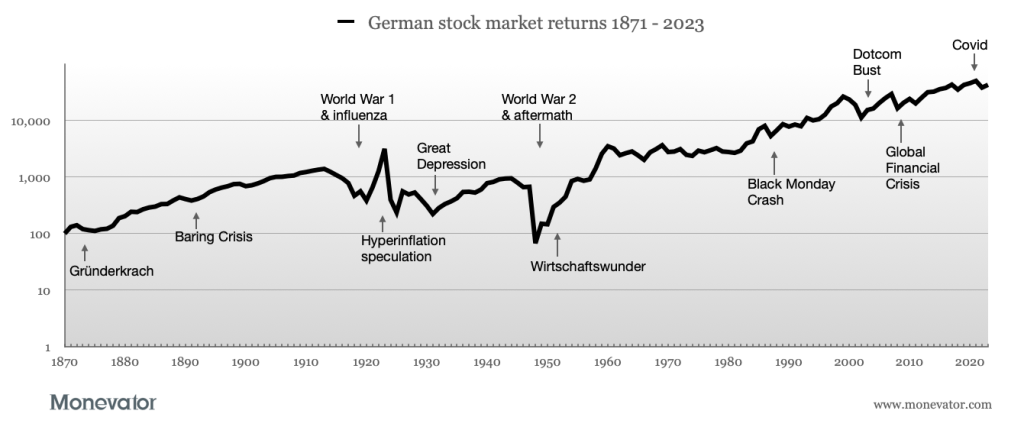
Today we are introducing a new Monevator investing experiment – a live trial of a retirement portfolio and its accompanying withdrawal strategy.
We’ve been updating our model Slow & Steady accumulation portfolio for nearly 13 years now.
Our new experiment – the No Cat Food portfolio – will be its decumulation equivalent.
The purpose: to help us track and discuss the adventures and dilemmas of living off a portfolio in retirement.
Consider this post the origin story for what will hopefully become a useful feature for Monevator members for years to come.
The hardest problem in personal finance
Accumulation can be as easy as riding a bike, once you know the basics.
But decumulation is more like attempting bunny-hops on a high-wire.
There’s new risks to think through, competing demands to juggle, and far more pressure to get each decision right once you press the retirement button.
An accumulation portfolio can play out its dramas on the sidelines of your real life. It may rise and fall more often than the Roman Empire, but that doesn’t matter too much so long as you don’t yet need it.
But one day you do need it. You retire, and now that precious bubble of resources is almost all you have to sustain you against the hard vacuum of retirement.
That’s the set-up we’re going for here. One where we’ve intentionally cut things a bit fine.
In our model portfolio, a happy retirement really does depend on us picking the right withdrawal strategy and having done our sums right.
The set-up
The No Cat Food portfolio must fund the income needs of a frugal-ish couple with no kids to support a modestly early retirement as follows:
Retirement age: 55
Time horizon: 45 years
Inheritance prospects: Nil
Legacy required: No
Withdrawal rate strategy: dynamic annual withdrawals
This situation bears more than a passing resemblance to my own, though some details differ.
Annual income requirement
Essential income: £22,000
Discretionary income: £6,000
Total net income required: £28,000
Note: essential and discretionary income are the components of net income, not in addition to it.
Over the years ahead our income needs will be adjusted for annual inflation.
Financial assets
We’re modelling as follows:
SIPPs: £700,000
Emergency fund: £30,000
House: £500,000 (no mortgage)
Back-up income sources: equity release, full state pensions in 13 years time.
I’m assuming everything is split 50-50 between our model couple. The portfolio above is therefore divided – perhaps too conveniently – into £350,000 x two SIPP accounts.
ISA accounts will be created once the SIPPs are in drawdown and we’ve got some tax-free cash to play with.
At that point both individuals will contribute £14,000 per year into a joint pot, while the tax strategy will rely upon two sets of personal allowances and so on.
Life expectancy
Our couple’s 45-year time horizon is derived from the ONS’ UK life expectancy calculator.
This tells us that the male of the species has an approximately 3.9% chance of making it to age 100.
Pour femme it’s 6.8%.
Together, that amounts to a 3% probability that there’s still a couple to fund when the King’s centenary telegram arrives, and 8% that at least one of them will make a century not out.
Let’s call it 10% to account for better than average health outcomes.
Our chosen retirement withdrawal rate will be conservative. But we’ll factor in a 10% chance of portfolio failure, too:
10% x 10% = 1% chance of the portfolio running dry and someone being alive to care.
Even in that scenario, there would still be the house equity to tap into. Plus opportunities to annuitise and top-up the state pension if the portfolio is tail-spinning.
So a 45-year time horizon seems good enough to cover longevity risk.
Check out our life expectancy for couples post for more data interrogation.
Income assumptions
£28,000 net annual income for two feels quite tight. The UK household average was £32,300 at the end of FY 2022 according to the ONS.
The Retirement Living Standards 2022 report offers £20,000 as a barebones income for a couple living outside of London. £34,000 qualifies as the middle ground.
I’ve dug into the report and while £20,000 looks tough, £34,000 is pleasingly baggy.
For what it’s worth, Mrs Accumulator and I spent £25,000 in FY 2021 and 2022. But inflation feels like it’s biting now and the frozen tax bands are closing in like trash compactor walls.
Hence I scale up FY 2024’s income requirement to £28,000. For my money, that still allows for a contented if lean-ish retirement for two. (The polo horses will have to go, though.)
The hard floor is £22,000 on essentials: utilities, food, and making the car go “brmmm”.
Reality check-in: any deaccumulation portfolio is going to be a one-size-fits-none affair. So don’t take it personally! You live in a different part of the country. You downsized. Your kids feed you three times a week. On weekdays you look after the offspring of a struggling family member. You have a cocaine and hookers habit. Who knows? We don’t. This is a model portfolio. It’s a vehicle to discuss the realities of drawing down an income over time, not a prescription as to how you should do it.
The height of our essential income floor presents us with our first real dilemma. Taking an inflation-adjusted £22,000 from our portfolio doesn’t leave a lot of room for manoeuvre if spending has to be cut later due to our withdrawal rate rules. This is a chink in the armour and things could get tricky if the market is crushed for years.
We’ll try to mitigate this by selecting an all-weather portfolio and opting for a modest initial withdrawal rate.
We won’t take an SWR bonus from the state pension either, and there’s the house as I mentioned.
Spending shocks
Who spends the same amount every year? Spending shocks are a fact of life, but they’re difficult to manage unless you’re rocking a generous savings or discretionary spending rate.
In our model portfolio scenario, however, both those advantages have been gambled away in exchange for the early retirement good life.
Enter the £30,000 emergency fund.
This fallback reserve will reside in a high interest, easy access savings account. It’ll be used when essential income needs swamp the annual withdrawal amount and the discretionary spending buffer zone, demanding extra cash NOW.
In the following year or so – and with the spending shock in the rear-view mirror – we’ll withdraw enough from the portfolio to replenish the emergency fund.
We judge our retirement withdrawal strategy can finance the occasional extra-large helping without setting the portfolio on the road to ruin.
Moreover, the dynamic withdrawal rate approach we’ll take will likely dispense bonus income in good years. We’ll use that surplus cash to make an inflation-adjusted contribution to the emergency fund.
But otherwise, we’ll play the emergency fund by ear.
I sleep much better at night knowing I have an emergency fund, personally, though I still live in fear of the roof blowing off. Unforeseen health-related expenses have dominated our first two years post-FIRE, too.
I don’t want the model portfolio hindered by too much of a cash drag, however. So we’ll dial the emergency fund up or down in the future as we gain more retirement spending experience.
Spending shock simulator
I’d like to build in a probability of annual overspend or underspend to help show how our retirement withdrawal strategy copes with lumpy consumption.
And happily enough, Monevator reader Paul sent me a spending volatility paper with just the data I need.
This T. Rowe Price research tells us that:
On average, about one in four retirees experienced at least a 17%–20% increase in annual spending over a two‑year period, while another one in four experienced at least a 20%–21% decrease in annual spending over a similar period.
So every year, I’ll roll the dice to determine if we fall into the overspend or underspend zone.
If we do, then we’ll use the following distribution taken from the paper to determine the amount of overspend:
This spending shock spread may be overstating the case because it’s averaged across income groups and includes some discretionary spending. The author’s don’t mention how it changes with age either.
But we will go with it as a simple model that indicates what can happen.
The paper’s authors didn’t publish the distribution for spending decreases. We’ll just assume it can vary from 0-30%.
Retirement spending decline
Will spending decline in retirement? The evidence mostly says yes, on average. But there’s a case against, too.
For individuals it’s a lottery.
Either way, your own health outcome is likely to decide whether spending drifts up or down over your retirement timeline.
Non-essential spending typically goes into steep decline from age 65 onwards, as retirees find themselves increasingly boxed-in by health issues.
This has affected The Accumulator household recently – even though we’re more than a decade away from our mid-60s.
More obviously, I can see how our parents’ horizons shrunk as they hit old age.
Another major factor is the impulse to keep putting something away for a rainy day – no matter what your age.
Morningstar modelled this declining spending by using an ‘annual inflation rate -1%’ income modifier in its State of Retirement Income report. So we’ll clip our retiree’s spending habits by the same from age 65.
That gives them a decade to enjoy the go-go years before time starts to catch up.
On this point, I’d like to quote Monevator reader AJ Buck, whose astute comment on advising retirees about their likely trajectory struck home with me:
So I now try to describe [the] shape of retirement spending – spend whilst you can enjoy it with a reducing income curve – or be frugal and have a rising income curve.
And then life gets in the way, throws in an unexpected illness and expense, or bereavement, and the whole plan goes to pieces.
Inflation
Inflation looms large in a retiree’s chamber of horrors. Indeed it’s often cited as one of the biggest threats to a comfortable retirement.
We were lulled to sleep on inflation over the past few decades. The last time the monstrous money swallower was a thing, my only financial concern was how many sweets I could buy with my paper round proceeds.
But back in those days you also saw an earlier generation of retirees doing paper rounds in order to prop-up pensions butchered by hideous 1970’s inflation.
The last couple of years have been an object lesson in how hard it is to hedge our portfolios against short-term drops in purchasing power.
It’s now all too easy again to appreciate how the spiralling cost of living can take T-Rex scale chunks out of the soft rump of your pension savings.
Anti-inflation platform
I’ll try to limit the damage that rising prices can do to our model couple’s lifestyle by building plenty of inflation protection into the portfolio.
Otherwise, we’re relying on the Bank of England to squeeze out inflation pronto, without throttling the economy while they’re at it.
Oh, and it’d be great if everybody could suppress their country invading, energy blackmailing, tariff-raising, pandemic spreading urges, too.
On a more practical level, we’ll adjust our retirement withdrawal rate annually by the CPIH inflation measure.
You can play along by calculating your personal inflation rate. The ONS has done its bit to help out by relaunching its personal inflation calculator.
(The ONS calculator tells me my personal inflation rate was 6% versus CPIH of 6.3%. I will never get that time back.)
Tax planning strategy
We’re not going to be funnelling cash through a Matryoshka doll set of shell companies. But with money too tight to mention, how can we make best use of our legitimate tax allowances?
Here’s the plan, per individual:
£350,000 SIPP portfolio goes into drawdown.
£87,500 of that can be taken out as tax-free cash.
As much of that as possible will then get invested into shares ISAs.
Our ISA headroom is £15,000 (each individual’s already-existing share of the emergency fund, held in a cash ISA) plus:
£20,000 ISA allowance for FY 2023-24.
£20,000 ISA allowance for FY 2024-25.
If we take our £87,500 tax-free cash in late March then we can fill one stocks and shares ISA before the 5 April 2024 tax year deadline, and the other from 6 April.
Meanwhile, the existing £15,000 cash ISA gets transferred, and invested into a shares ISA.
The emergency fund is then regenerated with £15,000 of tax-free cash dropped into an easy access savings account.
After all that jiggery-pokery, each individual will have:
£262,500 in SIPPs
£55,000 in stocks and shares ISAs
£32,500 in a taxable General Investment Account (GIA)
£15,000 cash in an easy access cash account
With this set-up, we should be able to keep the tax bill more or less at zero for a few years.
Each individual’s £14,000 income will be withdrawn like this:
£12,570 from the SIPP. Tax-free using the personal allowance.
£1,430 from the ISA / GIA. Tax-free using the ISA plus tax efficiency acrobatics in the GIA. (See below.)
Maximising tax efficiency
The easy access account is covered by the £1,000 personal savings allowance. Each individual should earn around £788 in interest during FY 2024-25 from their £15,000 emergency fund at current best buy rates. No problem.
The GIA is trickier. The dividend allowance shrinks to £500 in 2024-25 while the capital gains tax allowance is down to £3,000. Above those thresholds we get taxed.
We can minimise the hit by filling the GIA from the portfolio’s bond allocation. We’ll cover asset allocation in the next post in the series, but for now know that well over half the GIA will be invested in short-dated government bonds, with the remainder in intermediate government bonds.
These lower-volatility assets would need to make a capital gain of 9.66% before breaching the capital gains tax-free threshold.
Intermediate bonds rarely see that much gain in a year. Short bonds are even more inert. So this is the best combination of assets to park in the GIA until more ISA space becomes available in 2025-26.
At that point we sell enough from the GIA to fund the ISA – plus income needs not covered by the SIPP – without incurring capital gains tax.
But what about the income yielded by those unsheltered bonds in the GIA?
That’s covered by what’s left of the personal savings allowance, plus the mysterious ‘starting rate for savings’.
I’ve started so I’ll finish
Starting rate for savings is a 0% rate of income tax that can apply to savings income if your other sources of income are quite low.
It’s a quirky tax perk that is particularly relevant to retirees managing small pensions.
If your savings income plus your non-savings, non-dividend income sits below £17,570, then you should qualify for 0% income tax on any taxable savings interest you earn.
Let’s have an example.
You take £12,570 from your SIPP (counts as non-savings income).
You have no other sources of non-savings income and can disregard any taxable dividend income from the equation.
£17,570 – £12,570 = £5,000 of savings income that will be taxed at 0% under the starting rate for savings.
Every £1 of non-savings income you earn over £12,570 erodes your starting rate for savings allowance by £1. So your 0% band is eliminated if you earn over £17,570 in non-savings income.
(The upper limit can be increased if you’re eligible for additional tax-free allowances.)
Our model couple plans to take £12,570 from their SIPPs, meaning they’ll pay 0% tax on up to £5,000 in savings income.
That’s easily enough to cover any bond interest thrown off by their GIAs.
The taxman cometh
We’ll always withdraw up to the personal allowance from the SIPP. But at some point we’ll be forced over that threshold by either inflation or our dynamic withdrawal rate.
So income tax will be upon us soon enough. But I can’t see any advantage in emptying either the ISA or the SIPP before the other at this stage.
The ISA’s job is to suppress as much of the tax bill as possible – but only at a sustainable withdrawal rate.
So whatever withdrawal is allowed from the whole portfolio will be split proportionally between the SIPP and the ISA.
Perhaps later in life the ISA could do more of the heavy-lifting. Running it down could rein in future tax bills and help with means-testing if the entire retirement portfolio starts heading for the skids.
ISAs are also a liability if you’re likely to need social care funding.
But for now, I think the priority is to keep our tax strategy options open in the face of an uncertain future.
The ISA typically benefits if taxes rise. The SIPP if taxes fall.
Learn more about SIPPs vs ISAs.
I’m not sure it’s fair to say that Monevator Mavens over-index on low cunning, but I look forward to hearing about any other tax-optimisation manoeuvres that we should consider in the comments.
Stay tuned
It says something about the complexity of retirement withdrawal decisions that we’ve covered all this ground and not even talked about the investment side.
But to keep things manageable, I’ll cover the portfolio and withdrawal strategy in the next episode.
Once we’re underway, we’re planning two Maven member posts every year for our decumulation series.
The March post will cover portfolio performance and how much income our model couple can safely take. We’ll use dynamic withdrawal rate and dynamic asset allocation rules to squeeze more from our portfolio without driving it into the ground.
The September post will delve more into the psychology of decumulation, as well as a longer-range assessment of how our strategy is doing.
Hopefully the series will rumble on for years to come and prove to be a useful demo of retirement withdrawal strategy.
Please do let us know your ideas, too. One of the reasons we’re running this post well ahead of the No Cat Food portfolio’s launch in March is because we’d like to incorporate your thoughts and suggestions.
Take it steady,
The Accumulator
The post Retirement withdrawal strategy: introducing our decumulation series appeared first on Monevator.



